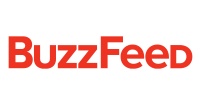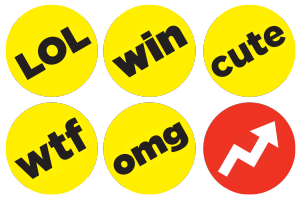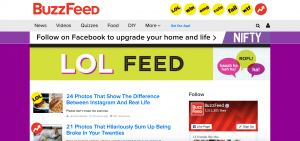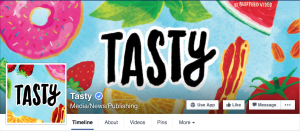BuzzFeed
|
Contents
History
BuzzFeed was founded in November of 2006 by MIT graduate, Jonah Peretti, who also co founded The Huffington Post in 2005. Peretti founded BuzzFeed as an experimental lab that concentrates on “tracking viral content” and “making things people wanted to share.”[3][4]
Funding
Eight years after its founding, BuzzFeed was able to raise $50 million from venture capitalist Andreessen Horowitz. Since then, multiple big investors have made equity investments into BuzzFeed, such as NBCUniversal and General Atlantic. As of July 30, 2015, BuzzFeed is worth $1.5 billion.[5]
Content
BuzzFeed produces articles and news daily and focuses on a variety of topics. The main headings (or main topics) include News, Videos, Quizzes, DIY, and More. Within the "More" section are 27 other headings which include Animals, Audio (information about podcasts, soundtracks, etc.), Big Stories, Books, Business, Buzz, Celebrity, Entertainment, Geeky (online fandoms and alike), Health, LGBT, Life, Music, Parents, Podcasts, Politics, Puzzles, Reader, Rewind (articles to remember the past), Science, Sports, Style, Tech, Travel, Weddings, Weekend (ideas for what to eat, make, or do over the weekend), and World.
There is also a separate navigation bar in the upper right hand corner of the desktop version of the homepage that allows for further filtering of articles. The options provided here are LOL, Win, OMG, Cute, Fail, WTF, and Trending.
Community
BuzzFeed has their own staff of over 700 employees, but they still encourage the community to write articles, and so BuzzFeed Community was created. This means that anybody who creates a BuzzFeed account can create their own content and quizzes to publish to the site and share with their friends. Prompts to do so can be seen under the More heading of the main topics navigation bar with a teal button suggesting the user, "Make a Post!" as well as the icon of a person next to the search bar which encourages creating an account. BuzzFeed uses a ranking system ("Cat Power") to determine how popular a user is among the Community. Cat Power increases as a contributor becomes more and more popular. Users can create a BuzzFeed account either using their Facebook account or creating a username and password with a valid email. Once they sign up, they will be able to post content under the community category. Users can post text, images, videos, or a mix of everything. On the BuzzFeed community front page, the most popular articles are shown. However, throughout the entire site of BuzzFeed, there are editors who decide which articles get posted to the homepage and promoted. [6]
Video
BuzzFeed creates multiple different video channels on both YouTube and Facebook. There is a general BuzzFeedVideo YouTube channel, but there are also multiple other channels categorized by color and their content divided by mood. The full list of these accounts is:
- BuzzFeedYellow (fun and happy content)
- BuzzFeedViolet (good, slightly awkward videos)
- BuzzFeedBlue (bite size knowledge for a big world)
- BuzzFeedCentral (features, news, documentation)
- BuzzFeedPop (pop culture content)
- After Party (a fun, miscellaneous account)
- BuzzFeedCeleb (short celebrity interviews)
- CNNBuzzFeed (a partnership account condensing CNN videos)
BuzzFeed also has several Facebook accounts, including BuzzFeed Food, BuzzFeed Video, BuzzFeed, BuzzFeed Quiz, BuzzFeed DIY, BuzzFeed Health, BuzzFeed Books, as well as pages for the rest of the topics covered in BuzzFeed's main headings on their site and pages for the various colors in the YouTube pages. They also have several spinoff accounts, such as Tasty or Proper Tasty (both recipe accounts). Most of these accounts are mainly quick, 15 second videos to show an interesting procedure or recipe for users.
Video Mobile Application
On February 23, 2016, BuzzFeed launched an all-video mobile application. This allows users to download a mobile application that contains only BuzzFeed videos. This application is very easy to use and provides a “super simple experience.” The mobile application has two sections: one which contains trending videos and another for browsing through other videos. The trending videos and independent and individual videos. In the other section, users can browse and subscribe to specific channels. If a user is subscribed to a channel, they will get a push notification whenever a new video or episode is uploaded. Instead of using YouTube or Facebook for their videos, BuzzFeed is using its own native video player. This gives them more control over how videos are used and delivered to the user. For example, BuzzFeed has an auto-play feature where videos continue to play. That would be difficult when using an embedded player or an existing video system. The video mobile application does not currently contain every video that BuzzFeed has ever created. It includes a big portion of their video catalog and in the future will include every new video. The BuzzFeed Video mobile application is currently available for iOS and Android. [7]
Newsletters
BuzzFeed offers to send newsletters to readers for the various subjects they are interested in. The newsletters are offered for the subjects of BuzzFeed Today (users receive this daily), Animals (3x a week), DIY (3x a week), Dude A Day (5x a week), Health & Beauty (2x a week), Sunday Features (once a week), BuzzFeed News (5x a week), Books (2x a week), Dog A Day (daily), Food (2x a week), Parents (2x a week), and This Week In Cats (once a week)3. These newsletters are helpful for those who do not have time to browse their favorite subjects, so BuzzFeed will send them a concise newsletter with the top articles of those subjects.
Advertisement
BuzzFeed generates revenue from advertisement through their site. Advertisers create their own posts related to their product or company, and BuzzFeed makes money from these advertisers. This is called native advertising because the posts look similar to BuzzFeed's typical content[8]. BuzzFeed provides help for brands and agencies to advertise on their site. An in-house creative team works with advertisers to help create custom social posts to share on BuzzFeed. The content varies depending on the advertiser but all content from advertisers are embedded into BuzzFeed. BuzzFeed works with the advertisers to help find the right audience and place the content on BuzzFeed accordingly. BuzzFeed has also partnered with companies to create videos with their company name on it. For example, BuzzFeed create a video called ‘GE’s “Are you A Visual Thinker?” BuzzFeed advertising has proven to be successful because they are integrated very naturally into the original BuzzFeed content. BuzzFeed has found that click-through rates for sponsored content on their site is 10x the industry standard for banner ads. These story units can be found on every category of BuzzFeed.[9]
Ethical Concerns
In January of 2015 Buzzfeed posted an article titled The Buzzfeed Editorial Standards and Ethics Guide, written by the executive editor of Buzzfeed. Its aim is to keep writers, editors and reporters accountable to their readers. This in depth article was divided into four sections: 1) Sourcing, 2) Corrections, Updates, Deletions and Errors, 3) Legal and Ethics, 4) The Editorial and Business Relationship. This article is to serve as a guide not an FAQ section of the website. It is a place for contributors to reference what they are doing prior to publishing something on the site. Buzzfeed has created a large and loyal following through contributors adhering to these standards.
Plagiarism
Since BuzzFeed conglomerates and generates information already found on the Internet, there has been a huge discussion on whether the content uploaded by BuzzFeed is considered plagiarism. In the summer of 2014, BuzzFeed documented the firing of their politics reporter Benny Johnson who was accused of plagiarism. BuzzFeed’s recent statement on ethics does not define plagiarism as specific to new media or whether or not the same standards apply to old school journalism, but rather is particular to computer use. BuzzFeed takes the content from the Internet and creates photos, videos, and .gifs with funny entertaining captions that summarizes different topics.
Political Advertising
It has been said that Buzzfeed has ventured in native ads for politicians. Native advertising is known as “paid posts” where the company is getting paid for the amount of consumers they have reached for a particular article. This brings up also the idea of lawful acts since many consumers do not realize that they are looking at an ad as they peruse the content. [10]
Accuracy of Articles
There have been numerous occasions when one of the "viral videos" or articles about viral events that BuzzFeed writes about have been hoaxes. This leads to BuzzFeed going back and editing articles. As they've grown as a company, BuzzFeed has recently decided that catching these errors after the fact is no longer acceptable and has made a point to do more fact-checking.[11]However, it is still possible for errors to slip through the cracks. BuzzFeed posts political articles occasionally, but especially around election season. If any of these are written as political opinion, it is possible that opinion could be perceived as fact, thus losing credibility.
TLDR
It might not be solely BuzzFeed's fault, but the format of BuzzFeed's site and articles encourages short bits of information in listed form. This has contributed to the TLDR generation. TLDR stands for 'Too long Didn't Read'. It's the idea that people are only willing to read so much. BuzzFeed articles seem to target Millennials with their short list-based articles filled with GIFs, Meme, and videos. As this still of "writing" continues how much will our reading and writing levels decrease? How much will the next generation need to be spoon fed in terms of content and information? It is truly concerning in some ways, but it in others it could just be the reality of how our society is evolving.
References
- ↑ Buzzfeed. ;http://www.buzzfeed.com/about "About Buzzfeed."] Retrieved on 14 March 2016
- ↑ Hilton, Shani O. "The BuzzFeed Editorial Standards And Ethics Guide." 30 January 2015. Retrieved on 14 March 2016
- ↑ ”The BuzzFeed Team”. BuzzFeed http://www.buzzfeed.com/about/team
- ↑ http://techcrunch.com/gallery/a-brief-history-of-buzzfeed/slide/14/
- ↑ Kosoff, Maya. "NBC is investing $250 million in BuzzFeed." 30 July 2015. Retrieved on 14 March 2016.
- ↑ BuzzFeed How To Use It http://www.buzzfeed.com/help/how_to_use#q2
- ↑ BuzzFeed Video Mobile Application http://techcrunch.com/2016/02/23/buzzfeed-creates-its-first-all-video-app/
- ↑ Weinberger, Matt. "BuzzFeed pays Facebook millions of dollars to promote its clients' ads." 12 August 2015. Retrieved on 14 March 2016.
- ↑ BuzzFeed Advertising http://www.buzzfeed.com/advertise
- ↑ Warren, James. "BuzzFeed enters potentially lucrative, ethically tricky world of native political ads." 12 October 2015. Retrieved on 23 April 2016
- ↑ Fisher, Marc. [1] "Who cares if it's true?"



